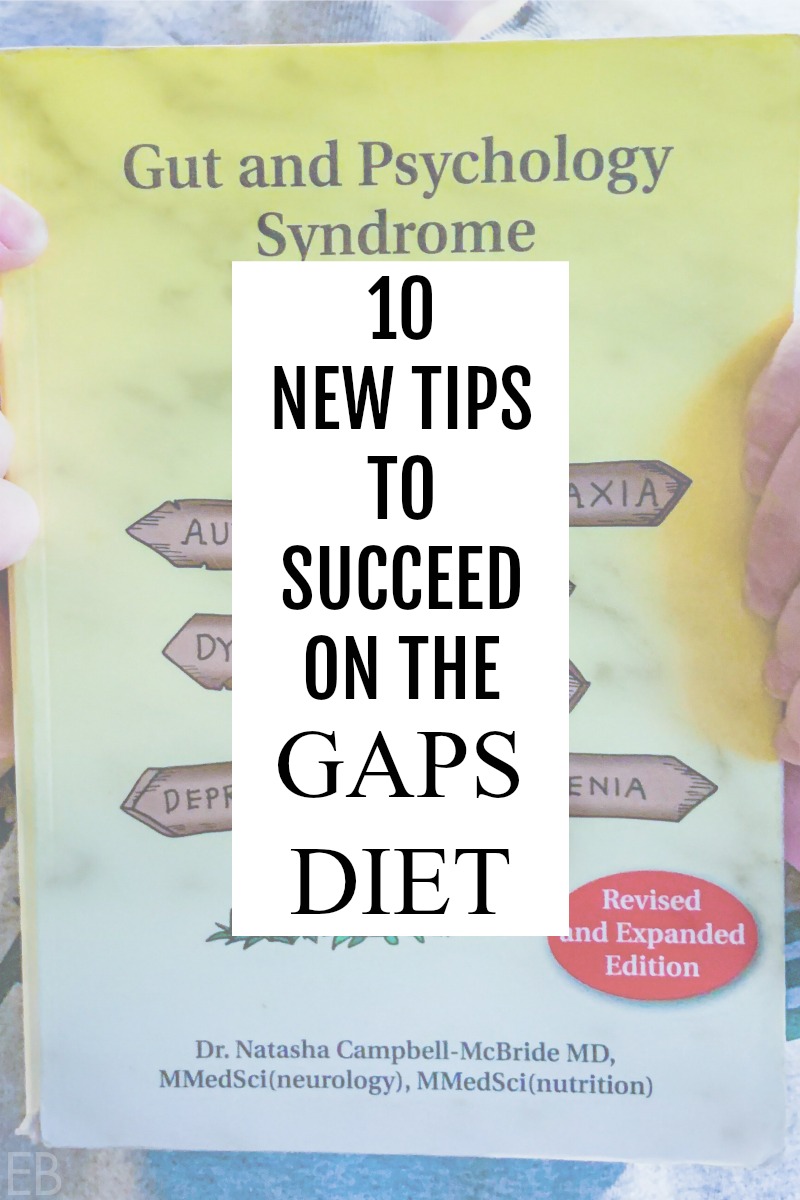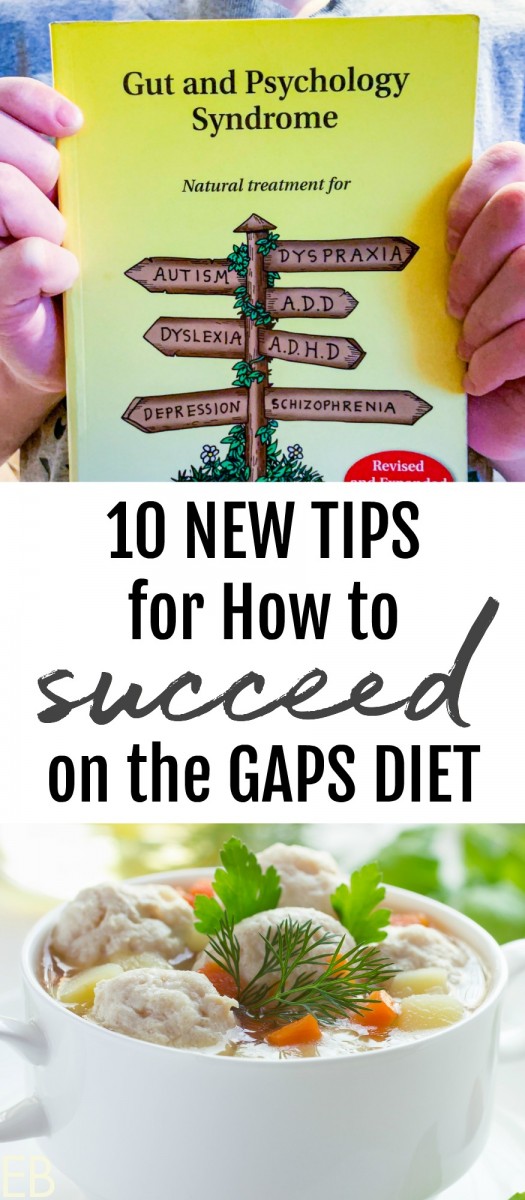I may receive a commission if you purchase through links in this post. I am not a doctor; please consult your practitioner before changing your supplement or healthcare regimen.
This post shares 10 tips for how to succeed with your wellness goals on the GAPS Diet.
My three children and I adhered to the GAPS Diet for over six years. We were among the first patients to follow the diet. We started the diet at a time when there were very few resources or recipes available to support our process. So we created recipes ourselves (see my cookbook here) and learned and researched along the way.

That segment of time was filled with healing, learning, yearning, rebelling, quelling and, thankfully, no yelling. 😉 Humor, deprivation, mistakes, successes, lots of family … and few regrets. What a bonding experience!
I cooked (and still cook most days) like a pioneer woman — making homemade meat patties for breakfast, roasted chicken for lunch and beef stew for dinner, with homemade, grain-free, gentle baked goods on the side … and usually a mug of bone broth.
We ate a lot of soup. We still eat a lot of soups and stews. (See my newly published cookbook of soup and stews here.)
Plus lots of cucumbers, sauerkraut, homemade yogurt, sprouted nut butter or grain-free granola at times and gummies.
We reached most of our goals, and as we still do a partial GAPS Diet and I meet with GAPS clients weekly, I am in a wonderful position to share with you some of the tips and insights I continue to learn about How to Succeed on the GAPS Diet. Here we go!
A little bit about me (and why I’m qualified to write this post)
Regarding my own credentials, I am quite openly self educated. 🙂 While I recommend you consider a functional medical doctor or a naturopathic physician, I am recommended by doctors to their patients and sought out by clients because of my breadth of experience with food, diet and cooking, as well as my own wellness journey, my devotion to research and my open-mindedness. I owned and ran a bone broth GAPS Diet café for many years, have authored two GAPS cookbooks and have taught ancestral cooking classes for several years. I do not claim to be a medical authority or have all the answers. 🙂 But I hope this post is helpful to you.
Tip 1. Read the book. But also look beyond the book.
The task of creating a healing diet that encompasses all obstacles and all nutritional insights is impossible. Since Dr. Natasha Campbell-McBride first wrote her book (find it here) eight years ago, she has increased her clinical experience. Ten years of seeing new patients and training new practitioners to help patients around the world have deepened her knowledge.
I hope Gut and Psychology Syndrome updated and edited at some point. While the book contains most of what you need to begin, there is so much more to know, especially for those of us with complex healing journeys.
If you work with a GAPS-trained practitioner (find one here), they will have considerable knowledge beyond the book. If you don’t, just remember to reread the book and have a network to further your research: friends, blogs, Facebook groups (here’s one for Full GAPS, and here’s one for Intro.) and the willingness to research, ask questions and try new things. Healing not only our own bodies, but often our children’s at the same time, rivals the work of a detective. 😉 We need updated and expanded resources.
Tip 2. Know about lectins, and consider eliminating them.
Tip 1 points to this tip, which is: There is nutritional information you may need that is NOT contained in the GAPS book. Many of us need new and additional nutritional and physiological insights for leaky gut to be healed.
Recently made famous by Dr. Steven Gundry, lectins, not too dissimilar from other anti-nutrients you may have learned about, are plant compounds that cause leaky gut and prevent it from healing. While many of us are educated about phytic acid and how to reduce it in nuts and seeds, very few people, relatively speaking, have heard about lectins.
Lectins could literally be one main thing standing in the way of healing. That’s because lectins are in many GAPS Diet staples: winter squash, zucchini, cucumbers, bell peppers and beans. The easy way to recognize a lectin-containing food? Is it a seed, nut or does it contain a seed? (There are some exceptions.)
While I embrace most truths that will get me well, I must admit, even I closed my eyes to lectins when I first learned about them. As in: Not another thing, please! I know you can relate. But if you get or have symptoms that won’t disappear, it may be time for you, too, to eliminate or significantly reduce lectins, to see what kind of progress you can make through their elimination.
Personally, I had stomach aches I couldn’t account for and a rash — until I eliminated most lectins. Removing those seedy foods finally allowed a new stage of my healing to happen. Here’s a good place to start learning more about lectins and how to remove them from your diet. To be clear, foods with lectins include most nuts, seeds and peanut butter! (Sorry!)
I also lost (and have kept off) eight pounds when I eliminated foods high in lectins.
For a low-lectin grocery list combined with a low histamine diet, see this article … which includes the nuts and seeds that you can still eat on a low-lectin diet. 🙂
Tip 3. Be willing to give up nightshades.
Nightshades cause inflammation (often in the form of joint pain, bloating, puffiness and rashes) for many patients. Nightshades include not only the most well known produce items, tomatoes, eggplant, potatoes and peppers, but also goji berries, herbs like ashwagandha and well loved spices like paprika and cayenne.
Find a full list of nightshades here, and consider alternatives to these favorites. (For example, try delicious and healthy Nomato Sauce.)
Tip 4. Be willing to give up GAPS Diet foods, while on the GAPS Diet!
Just when you think your diet can’t be any more restrictive, it can. Of course, if you’re not ready emotionally, then wait. It’s okay to wait.
Alternately, if you’re READY to be well and beyond your symptoms or to really help your child, then focus on the good things you CAN eat to get you through this period of deprivation.
I was down to just three foods for one stage of my healing process, but it was helpful and worth it. I ate just homemade pork sausages, carrots and zucchini for about a year. (I’m not suggesting you do this.) All other foods caused horrible rashes and stomach aches! By removing chicken, beef, lamb and all other veggies, I gave my body a break and was able to find healing modalities that set me back on the path to healing.
Ultra-restricted diets can reduce inflammation and give us time to research or gain new insights. They don’t last forever. Breaks from aggravating foods offer a potential path for new progress and breakthroughs.

Tip 5. Be aware of too much vitamin A.
This insight is the most important one I’ve learned since graduating from GAPS to wellness. While a profoundly surprising concept when I first read about it, too much Vitamin A is potentially toxic and can actually exacerbate and prolong leaky gut conditions, including eczema, low stomach acid, an imbalance of gut flora and mental health issues — especially for those of us with compromised detoxification pathways.
You can read more about the Vitamin A Detox diet here. The VAD diet can be combined with GAPS, and I have multiple clients combining VAD with GAPS or AIP, seeing encouraging progress for skin and gut conditions as well as mental health issues and more. Personally, the first benefits I saw were mental health related and then skin and gut.
Tip 6. Consider castor oil packs for liver cleansing and reducing inflammation.
Some of you know this tip already. But it took me YEARS to finally use this protocol. I did it toward the end of our GAPS journey when one of my older kids and I had some symptoms that signaled liver congestion. Because reducing inflammation is always a good idea, I started castor oil packs for both of us (source).
Like most moms and kids, we like watching movies and reading books, and that’s the fun part of castor oil packs. They provide a time of true rest, during which the body does some dramatic healing.
In The Oil That Heals, Dr. William McGarey (find it here) describes two studies wherein patients had increased lymphatic activity from the regular use of castor oil packs. Our lymphatic system is the roadway on which toxins are ushered from the body. So increased lympthatic activity means detoxification. Added to all this, castor oil packs are gentle for most people.
Ask your practitioner if you’re not sure if castor oil packs are right for you. Read here about how to use castor oil packs.
Tip 7. Make sure you’re supporting your detox pathways in other ways too.
My favorite way to detox is through use of our near infrared sauna. We have a two person sauna in our bedroom. What I wouldn’t sell to hold on to this one possession! 😉 The sauna has done wonders for my health and my teenage daughter’s! We bought a scratch and dent/floor model to save money. If your budget is tight, I personally believe they’re worth saving up for. Here is my favorite near infrared sauna site; they offer different models for different budgets.
My other favorite way to detox is through grounding, or earthing. What finally allowed me to move past the three foods I was stuck with was a vacation to Southern California. The beach and sun allowed my body to detox in ways that the Pacific Northwest did not. Read more about this miracle here. I continue to ground regularly even here in Oregon.
Be sure to integrate or consider dry brushing. This ritual takes just five minutes and can be practiced three to four times a week before your detox bath.
Also, consider supplements that aid in detoxing.
Tip 8. Include a few supplements.
While supplements aren’t encouraged initially on GAPS, here are a few to consider and from which to benefit:
- Magnesium plays a role in over 300 biochemical reactions in the body, including regularity (regular bowel movements are a key to detoxing). (My family takes these tablets, and I take this powder because it’s not synthetic and means fewer pills to swallow.)
- A good B complex, without synthetic vitamin A, facilitates detoxification. (I like and use this one.)
- Gentle ferments and prebiotics from food (the best source for both are fermented asparagus, fermented onions or fermented garlic).
- Supplements to treat specific conditions: for example, diatomaceous earth for pathogen overgrowth and/or worms (read about using it here) or herbal antibiotics for pathogen overgrowth (read more about how-to here).
- Add minerals to your diet with fulvic acid.
- Using apple cider vinegar (or lemon juice or gentian tincture) alongside activated charcoal helps to cleanse the liver and pull internal toxins out through the alimentary canal. I’ll write more on this soon, but I love the results I’ve seen from this daily ritual.
Feel free to ask in the Comments section below if you have any questions. Work with a good holistic practitioner (naturopathic or functional) to find the right supplements, but also do your own research. While we started the GAPS diet without any supplements, adding several in was a key step to improving our health.
Tip 9. What are other dietary limitations that may be helpful?
Low-oxalate (learn more here), low salicylate, low-FODMAP (insights here), low-histamine (combined with lectin-free here, because they’re linked), anti-candida (how-to here) and, as mentioned, the Vitamin A Detox diet. I’m currently of the opinion that most sensitivities can be overcome through a low Vitamin A diet combined with a grain-free, sugar-free protocol and a few well-chosen supplements.
Also learn about food intolerances here. The difference between a food sensitivity, a food allergy and a food intolerance is the difference between being stuck and overcoming major health challenges. My daughter put her asthma into remission when we learned her food intolerance was dairy, and I put my incurable bladder disease into remission when I learned my food intolerance was all fruit (and eliminated it from my diet). I was completely lethargic after every meal I ate on GAPS that included fruit, but didn’t know why. Pulled fruit, got well.
Tip 10. Don’t hurry through Intro, even with the little things.
Don’t hurry means:
- Drink meat stock instead of bone broth. Here is how to make both and the differences.
- Use lots of fresh ginger.
- Wait to sauté.
- Use an Instant Pot (HERE).
- Make great soups.
- Use a steam basket (here or the Instant Pot steam basket here).
- Wait on nuts and seeds, even the pancakes with nut butter and squash described in the book.
- Restart Intro if needed; plan on it! Read more about how to go slowly on Intro here.
- Combine Intro with the Vitamin A Detox diet for faster and truer benefits.



Raia Todd says
So helpful, Megan! Thank you so much for sharing all you’ve learned on your journey with GAPS and wellness! I know I wouldn’t be where I am today health-wise if it hadn’t been for your freely-given wisdom. 🙂
Megan says
Thank you, Raia, so sweet. I’m so glad!!
Selma says
Hello Megan,
We bought your new cookbook recently as an ebook and have REALLY enjoyed using your recipes and implementing your ideas. It’s simply wonderful!!!
I have a question; we are thinking of buying a sauna for awhile now and see your link leads to “ Sauna Space,” can I ask… do they really have a two person sauna?
My husband prefers we would get at least a two person sauna, but I much prefer the “ Sauna Space” one, which seems to be only for one person. Can you explain a bit?
Selma
Megan says
Hi Selma, I’m so happy you’re enjoying the cookbook so much, yay!! 🙂 Thank you!
Regarding sauna models, I do think the technology offered by SaunaSpace is superior to any other sauna out there. If you both read extensively on their website (as you may have already), I’ll think you’ll agree. So one or two person is less important (IMO) than the return on your investment and the quality of the health benefits. The light width is intended for one body with SaunaSpace. My husband and I have a two-person zero-EMF sauna that’s great, but we’re adding the SaunaSpace red light therapy to it. When we first got our two-person sauna, we took saunas together, as it’s a nice way to talk and connect. But the longer we own our sauna, I actually prefer to sauna by myself. I found that it’s very cleansing for my mental health. Alone time in the sauna allows me to pray and let go of burdens, so I’m getting a double/triple benefit (mind, body, spirit). So again, that approach supports SaunaSpace’s single man high quality product. I hope that helps?